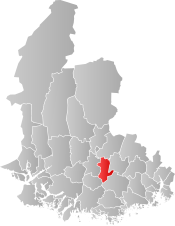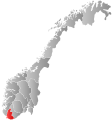Laudal (municipality)
Laudal herred | |
|---|---|
 Laudal within Vest-Agder | |
| Coordinates: 58°14′49″N 07°30′16″E / 58.24694°N 7.50444°ECoordinates: 58°14′49″N 07°30′16″E / 58.24694°N 7.50444°E | |
| Country | Norway |
| County | Vest-Agder |
| District | Sørlandet |
| Established | 1 Jan 1899 |
| • Preceded by | Øyslebø og Laudal Municipality |
| Disestablished | 1 Jan 1964 |
| • Succeeded by | Marnardal Municipality |
| Administrative centre | Laudal |
| Area (upon dissolution) | |
| • Total | 93 km2 (36 sq mi) |
| Population (1964) | |
| • Total | 560 |
| • Density | 6.0/km2 (16/sq mi) |
| Demonym | Laudøl[1] |
| Time zone | UTC+01:00 (CET) |
| • Summer (DST) | UTC+02:00 (CEST) |
| ISO 3166 code | NO-1022 |
Laudal is a former municipality located in the old Vest-Agder county in Norway. The 93-square-kilometre (36 sq mi) municipality existed from 1899 until 1964. The administrative centre of the municipality was the village of Laudal where Laudal Church is located. The municipality encompassed part of what is now the municipality of Lindesnes in Agder county.[3]
History
The municipality was established on 1 January 1899 when the old municipality of Øyslebø og Laudal was divided into two municipalities: Øyslebø (population: 991) and Laudal (population: 836). During the 1960s, there were many municipal mergers across Norway due to the work of the Schei Committee. On 1 January 1964, Laudal municipality was dissolved and its land was merged with parts of the neighboring municipalities of Øyslebø, Bjelland, and Finsland to create the new municipality of Marnardal. Prior to the merger, Laudal had a population of 560.[4]
Name
The municipality (originally the parish) is named after the old Laudal farm (Old Norse: Laugardalr), since that is the location of Laudal Church. The first element of the name of the farm comes from the old name for the river, Laug, (now the Lågåna river) and the last element (Old Norse: dalr) means "valley". Therefore, the name means "Laug river valley".[3][5]
Government
All municipalities in Norway, including Laudal, are responsible for primary education (through 10th grade), outpatient health services, senior citizen services, unemployment and other social services, zoning, economic development, and municipal roads. The municipality was governed by a municipal council of elected representatives, which in turn elected a mayor.[6]
Municipal council
The municipal council (Herredsstyre) of Laudal was made up of representatives that were elected to four year terms. The party breakdown of the final municipal council was as follows:
| Party Name (in Norwegian) | Number of representatives | |
|---|---|---|
| Labour Party (Arbeiderpartiet) | 5 | |
| Joint List(s) of Non-Socialist Parties (Borgerlige Felleslister) | 8 | |
| Total number of members: | 13 | |
| Party Name (in Norwegian) | Number of representatives | |
|---|---|---|
| Labour Party (Arbeiderpartiet) | 5 | |
| Joint List(s) of Non-Socialist Parties (Borgerlige Felleslister) | 8 | |
| Total number of members: | 13 | |
| Party Name (in Norwegian) | Number of representatives | |
|---|---|---|
| Labour Party (Arbeiderpartiet) | 5 | |
| Joint List(s) of Non-Socialist Parties (Borgerlige Felleslister) | 7 | |
| Total number of members: | 12 | |
| Party Name (in Norwegian) | Number of representatives | |
|---|---|---|
| Labour Party (Arbeiderpartiet) | 5 | |
| Joint List(s) of Non-Socialist Parties (Borgerlige Felleslister) | 7 | |
| Total number of members: | 12 | |
| Party Name (in Norwegian) | Number of representatives | |
|---|---|---|
| Labour Party (Arbeiderpartiet) | 6 | |
| Farmers' Party (Bondepartiet) | 3 | |
| Joint list of the Liberal Party (Venstre) and the Radical People's Party (Radikale Folkepartiet) | 3 | |
| Total number of members: | 12 | |
| Party Name (in Norwegian) | Number of representatives | |
|---|---|---|
| Labour Party (Arbeiderpartiet) | 5 | |
| Farmers' Party (Bondepartiet) | 5 | |
| Liberal Party (Venstre) | 2 | |
| Total number of members: | 12 | |
| Note: Due to the German occupation of Norway during World War II, no elections were held for new municipal councils until after the war ended in 1945. | ||
See also
References
- ^ "Navn på steder og personer: Innbyggjarnamn" (in Norwegian). Språkrådet.
- ^ "Forskrift om målvedtak i kommunar og fylkeskommunar" (in Norwegian). Lovdata.no.
- ^ a b Store norske leksikon. "Laudal" (in Norwegian). Retrieved 22 November 2016.
- ^ Jukvam, Dag (1999). "Historisk oversikt over endringer i kommune- og fylkesinndelingen" (PDF) (in Norwegian). Statistisk sentralbyrå.
- ^ Rygh, Oluf (1912). Norske gaardnavne: Lister og Mandals amt (in Norwegian) (9 ed.). Kristiania, Norge: W. C. Fabritius & sønners bogtrikkeri. p. 99.
- ^ Hansen, Tore, ed. (12 May 2016). "kommunestyre". Store norske leksikon (in Norwegian). Kunnskapsforlaget. Retrieved 21 November 2020.
- ^ "Kommunevalgene og Ordførervalgene 1959" (PDF) (in Norwegian). Oslo: Statistisk sentralbyrå. 1960. Retrieved 21 November 2020.
- ^ "Kommunevalgene og Ordførervalgene 1955" (PDF) (in Norwegian). Oslo: Statistisk sentralbyrå. 1957. Retrieved 21 November 2020.
- ^ "Kommunevalgene og Ordførervalgene 1951" (PDF) (in Norwegian). Oslo: Statistisk sentralbyrå. 1952. Retrieved 21 November 2020.
- ^ "Kommunevalgene og Ordførervalgene 1947" (PDF) (in Norwegian). Oslo: Statistisk sentralbyrå. 1948. Retrieved 21 November 2020.
- ^ "Kommunevalgene og Ordførervalgene 1945" (PDF) (in Norwegian). Oslo: Statistisk sentralbyrå. 1947. Retrieved 21 November 2020.
- ^ "Kommunevalgene og Ordførervalgene 1937" (PDF) (in Norwegian). Oslo: Statistisk sentralbyrå. 1938. Retrieved 21 November 2020.
- CS1 Norwegian-language sources (no)
- Articles with short description
- Short description with empty Wikidata description
- Coordinates not on Wikidata
- Articles containing Old Norse-language text
- Articles containing Norwegian-language text
- Articles containing Bokmål-language text
- AC with 0 elements
- Use dmy dates from November 2020
- Lindesnes
- Former municipalities of Norway
- 1899 establishments in Norway
- 1964 disestablishments in Norway


